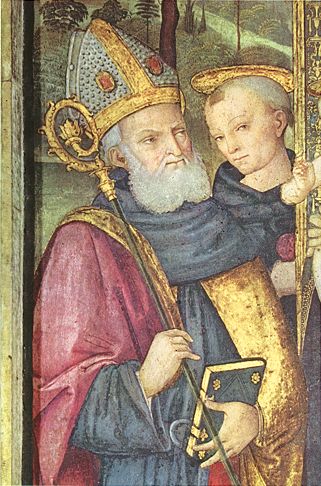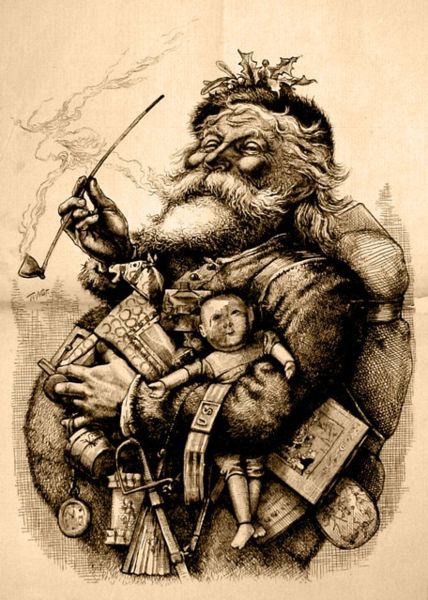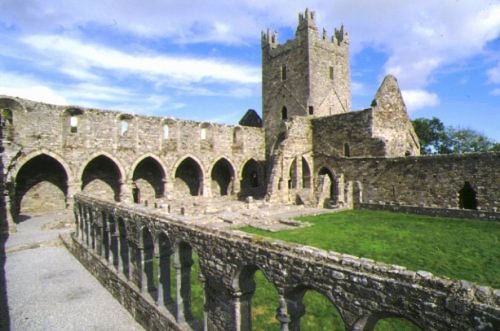 Kemberlee Shortland, Copyright December 2011
Kemberlee Shortland, Copyright December 2011"Dear Editor, I am 8 years old. Some of my little friends say there is no Santa Claus. Papa says, "If you see it in The Sun, it's so." Please tell me the truth, is there a Santa Claus? ~Virginia O'Hanlon"
Have you ever wondered if there really was a Saint Nicholas? And if he existed, what happened to him? He really did exist you know, and I can tell you what happened to him.
Nicholas was born in Patara of Lycia, Turkey, sometime in the middle of the 3rd century. His birth date is disputed as being somewhere between 245-271AD.
He was the only child born to wealthy parents who provided him with a very Christian upbringing.
Unfortunately, Nicholas was orphaned at an early age when his parents died of the Plague and was sent to live in the monastery in Myra.
Under the guidance of the bishop there, Nicholas was educated and became ordained in his 20s. At the age of 30, on the death of the bishop, Nicholas was elected to be replaced as the new Bishop of Myra of Lycia. Nicholas became well known for his charity and his devoutness during his lifetime.
It's said that his faith was so great that his prayers calmed a stormy sea while on a trip to the Holy Lands.
He is also credited with the concept that Father, Son and Holy Spirit exists as one.
He was also well known for his kindnesses, charity and love of children. As a man of great wealth, having inherited from his family, he used his money to fund a poorhouse, hostelries and a hospital. He also donated money to poor families, especially children's charities.
Nicholas was the personification of Christian love and affection, and is one of the most widely known historic figures in the world. His memory is honored through all corners of the Earth. Especially in western civilization where he is considered the great patron saint of children. As Nicholas gave gifts to the children he so well loved during his lifetime, we continue the tradition by trading gifts with those we love today.
Nicholas died on the 6th of December, between 342-345AD, and was interred in the cathedral at Demre in Turkey. He was canonized in medieval times and made a saint.
Though Nicholas is long gone, his memory has remained alive for centuries, gaining many followers throughout Europe. Thousands of churches were built in his honor in the Middle Ages, nearly a Millennium after his death! It's said that there are more churches dedicated to St Nicholas around the world than to St Patrick.
To St Nicholas's honor, 6 December became the Feast of St Nicholas Day, and the exchange of gifts remained popular, especially with children.
Why is St Nicholas connected with gift giving? Well, Nicholas would ride to the homes of children in his parish on a donkey. He wore his bishops robes of red and white and bore gifts, usually of fruit, nuts, hard candies and sometimes clay or wood toys, that he'd leave on the mantel. This tradition continued from the mid 3rd century to the 16th century.
During the Protestant Reformation in the 16th century, most of Europe saw the banishment of St Nicholas from its churches as his memory was aligned with that of Catholicism. Protestants refused to recognize any saint with connections to the Catholic Church. The gift giving tradition was forced underground, as did Catholicism. Practicing Catholics were forced to worship secretly in private homes and often at "mass rocks" in the countryside.
The Dutch are credited with keeping the tradition alive when they established New Amsterdam (New York USA) in the 1600s when they brought their traditions with them, including St Nicholas who remained their patron saint.
By the early 19th century, Catholicism saw a resurrection, and the traditions that had been secreted for so long
 were able to come back into practice, and into fashion.
were able to come back into practice, and into fashion.Today, gift giving in St Nicholas's memory is alive and well and living throughout the world, and being practiced by most Christian faiths. Gift giving is a worldwide event that touches the hearts of millions --
• 6 December is still the traditional day of gift giving in the Netherlands and Germany, the German's calling the day "Nicholas Day" when an old shoe is placed on the doorstep overnight, which St Nicholas fills with gifts and sweets.
• In western Germany he's known as Klaasbuur, Sunnercla, Burklaas, Bullerklaas, and Rauklas. And in eastern Germany he's called Shaggy Goat, Ash Man and Rider. His helper is known as Knecht Ruprecht (Ruprecht the helper) all over Germany.
• In the Netherlands he's known as Sinterklaas (which was Anglicized as Santa Claus), and is said to travel from Spain in a steamboat two weeks before the 6th of December with his helper Zwarte Piet (Black Pete), who helps deliver the gifts.
• In France, he's known as Pere Noel (Father Christmas). His helper is Pere Fouettard (French for the Whipping Father). Pere Noel leaves presents for good children, while Pere Fouettard disciplines bad children with a spanking.
• St. Nicholas Day was celebrated formerly in Russia, but under Communism he was changed to Grandfather Frost and wore blue instead of red.
• In Sicily, he comes on December 13th and is called Santa Lucia.
• In the rest of the western world, he remains St Nicholas, and the gift giving day has moved to the 25th of December, which now coincides with the suspected date of the birth of Christ (see below for why Christmas and Christ's birthdays are celebrated together).
But no matter what name you know him by St Nicholas will probably always be best known simply as Santa Claus.
Throughout the world, families create their own traditions, which include many similar aspects some of which include the decoration of a tree, a feast for the family and gifts for loved ones.
 According to legend, Saint Nicholas is now said to be buried in Ireland at Jerpoint Abbey in County Kilkenny. While retreating during the Crusades, the Knights of Jerpoint removed St Nicholas's body from his tomb at Myra, Turkey and reburied him in the Church of St. Nicholas to the west of Jerpoint Abbey.
According to legend, Saint Nicholas is now said to be buried in Ireland at Jerpoint Abbey in County Kilkenny. While retreating during the Crusades, the Knights of Jerpoint removed St Nicholas's body from his tomb at Myra, Turkey and reburied him in the Church of St. Nicholas to the west of Jerpoint Abbey.Check out Bill Watkins's song about St Nicholas--
The Bones of Santa Claus
© Bill Watkins
Where lie the bones of Santa Claus
To what holy spot each pilgrim draws
Which crypt conceals his pious remains
Safe from the wild wind, snows and rains.
It's not in Rome his body lies
Or under Egypt's azure skies
Constantinople or Madrid
His reliquary and bones are hid.
That saint protector of the child
Whose relics pure lie undefiled
His casket safe within it's shrine
Where the shamrocks grow and rose entwine.
Devout wayfarer, cease your search
For in Kilkenny's ancient church
Saint Nicholas' sepulcher is found
Enshrined in Ireland's holy ground.
So traveler rest and pray a while
To the patron saint of orphaned child
Whose bones were brought to Ireland's shore
Safe from the Vandal, Hun and Moor.
Here lie the bones of Santa Claus
Secure beneath these marble floors
So gentle pilgrim, here the call
And may Saint Nicholas bless you all.
To learn more about Santa Claus, click here.
- - - - - - - - - - - - - - - - - - - - - - - - - - - - - - - - - - - - - -
The birth of Christ and Christmas
The Bible says Jesus was born when the lambs were in the fields. This time of year falls between April and October. Jesus was known to be 'half a year younger than John the Baptist,' who was born in late April. John's mother Elizabeth was close friends with Mary. Mary visited Elizabeth on the birth of her son to tell her the angel Gabriel came to tell her that she would also have a son. As John is six months older, this puts Jesus' birth sometime between late September/early October. As Jesus was 33.5 years old when he died, which was April, going back by six months takes us back to late September/early October, twice confirming this period as Jesus' birth date.
When citizens were called to Palestine to pay their taxes, it would have been too cold to ask so many people to travel in December. This event took place in the summer or early fall months.
It wasn't until the 4th century when Christianity started spreading worldwide that Jesus' birth became an issue. It was during that time when priests began spreading the word of the One God around Europe. Those priests were eventually canonized . . . St Patrick and St Brigit in Ireland, St David in Wales, St Andrew in Scotland, St George in Britain, etc. -- including Nicholas from Turkey who became St Nicholas, as above.
During the 4th and 5th centuries priests merged Pagan feast days with Christian holy days in order to convert "heathens" to Christianity. It was easy to tell people their gods' festival days coincided with Christian festivals. How could it be disputed? People didn't know. There was no reason to dispute the claims of the Christian priests so Pagans were easily converted.
For example --
• Bealtaine (1 May and the first day of summer) became May Day;
• Samhain (which is actually a Gaelic word for the month of November and the first day of winter) became Halloween/All Hallows Eve (31 Oct);
• Imbolc (2 Feb) became St Bridget's Day which eventually became Groundhog Day;
• Paschal Day become Easter, etc.
The date chosen to celebrate Christmas stems from a few things. The most accurate story which tells that the feast of Sol Invictus (Unconquered Sun) was celebrated on December 25. When Christian priests were converting pagans from the 4th century, they were told that Nicholas's birth coincided with that of their Sun God who was said to have been born on 25 December . . . and it was the 25th that a mass for Christ began being celebrated. Christ's mass became Christmas, and over the centuries the legend of St Nicholas and Christmas evolved to what we celebrate today.
- - - - - - - - - - - - - - - - - - - - - - - - - - - - - - - - - - - - - -
However you celebrate your Christmas, Nicholas Day or Yuletide, make it a good one.
*´¨)
¸.•´¸.•*´¨) ¸.•*¨)
(¸.•´ (¸.•` ¤ Happy Holidays everyone!!*´¨)